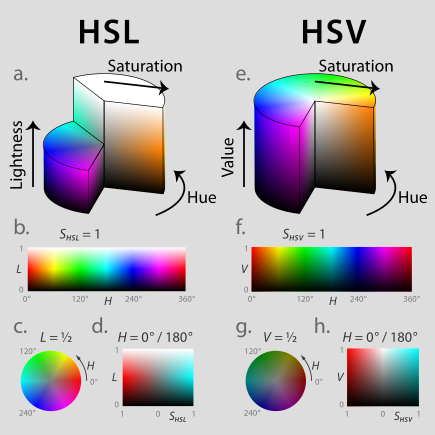Exercise Implement other coloring brightness tools such as HSV value V, HSL lightness L or Component average.
Introduction #
The goal in this exercise is to apply different color models to analyze better the characteristics of an image. Models such as HSV or HSL.
Previous Work #
The HSL representation models the way different paints mix together to create color in the real world, with the lightness dimension resembling the varying amounts of black or white paint in the mixture (e.g. to create “light red”, a red pigment can be mixed with white paint; this white paint corresponds to a high “lightness” value in the HSL representation). Fully saturated colors are placed around a circle at a lightness value of ½, with a lightness value of 0 or 1 corresponding to fully black or white, respectively.

Implementation #
Solution #
In order to extract the values we want to represent, it is necessary to apply certain transformation to the red, blue and green values.
First we have the HSV “hexcone” model:
Then we have the In the HSL “bi-hexcone” mode, defined as follows:
Funciones para aplicar luma, hsl, hsv:
float luma(vec4 texel) {
// alpha channel (texel.a) is just discarded
return 0.299 * texel.r + 0.587 * texel.g + 0.114 * texel.b;
}
float hsv(vec4 texel) {
// alpha channel (texel.a) is just discarded
return max(texel.r,max(texel.g,texel.b));
}
float hsl(vec4 texel) {
// alpha channel (texel.a) is just discarded
return (max(texel.r,max(texel.g,texel.b))+min(texel.r,min(texel.g,texel.b))) / 2.0;
}
Selection of the values along with uv visualization
void main() {
// texture2D(texture, texcoords2) samples texture at texcoords2
// and returns the normalized texel color
vec4 texel = texture2D(texture, texcoords2);
gl_FragColor = uv ? vec4(texcoords2.xy, 0.0, 1.0) :
lightness ? vec4(vec3(luma(texel)), 1.0) :
v_value ? vec4(vec3(hsv(texel)), 1.0) :
l_value ? vec4(vec3(hsl(texel)), 1.0) :
texel;
}
Code #
Code
let lumaShader;
let hsvShader;
let src;
let img_src;
let video_src;
let video_on;
let lightness;
let uv;
let hsv;
let hsl;
function preload() {
lumaShader = readShader('../../../../sketches/extra/luma.frag',
{ varyings: Tree.texcoords2 });
//hsvShader = readShader('../../../../sketches/extra/hsv.frag',
// { varyings: Tree.texcoords2 });
video_src = createVideo(['../../../../sketches/shaders/wagon.webm']);
video_src.hide(); // by default video shows up in separate dom
// image source: https://t.ly/Dz8W
img_src = loadImage('https://picsum.photos/id/401/600');
src = img_src;
}
function setup() {
createCanvas(700, 500, WEBGL);
noStroke();
textureMode(NORMAL);
shader(lumaShader);
video_on = createCheckbox('video', false);
video_on.position(10,90)
video_on.style('color', 'white');
video_on.changed(() => {
src = video_on.checked() ? video_src : img_src;
video_on.checked() ? video_src.loop() : video_src.pause();
});
video_on.position(10, 10);
hsv = createCheckbox('hsv', false);
hsv.position(10, 10);
hsv.style('color', 'white');
hsv.input(() => lumaShader.setUniform('v_value', hsv.checked()));
hsl = createCheckbox('hsl', false);
hsl.position(10, 30);
hsl.style('color', 'white');
hsl.input(() => lumaShader.setUniform('l_value', hsl.checked()));
lightness = createCheckbox('luma', false);
lightness.position(10, 50);
lightness.style('color', 'white');
lightness.input(() => lumaShader.setUniform('lightness', lightness.checked()));
uv = createCheckbox('uv visualization', false);
uv.style('color', 'white');
uv.changed(() => lumaShader.setUniform('uv', uv.checked()));
uv.position(10, 70);
}
function draw() {
/*
NDC quad shape, i.e., x, y and z vertex coordinates ∈ [-1..1]
since textureMode is NORMAL u, v texture coordinates ∈ [-1..1]
see: https://p5js.org/reference/#/p5/beginShape
https://p5js.org/reference/#/p5/vertex
y v
| |
(-1,1,0)| (1,1,0) (0,1) (1,1)
*_____|_____* *__________*
| | | | |
|____NDC____|__x | texture |
| | | | space |
*_____|_____* *__________*___ u
(-1,-1,0) (1,-1,0) (0,0) (1,0)
*/
lumaShader.setUniform('texture', src);
//hsvShader.setUniform('texture', src);
beginShape();
// format is: vertex(x, y, z, u, v)
vertex(-1, -1, 0, 0, 1);
vertex(1, -1, 0, 1, 1);
vertex(1, 1, 0, 1, 0);
vertex(-1, 1, 0, 0, 0);
endShape();
}
Conclusions #
In conclusion, the use of HSV and HSL color models offers significant advantages in working with RGB images. These models provide a more intuitive representation of colors, facilitate color selection and customization, simplify image processing tasks, and enhance data visualization. Incorporating HSV and HSL color models into workflows can lead to more efficient and effective results in various domains.
References #
- HSL and HSV. Wikipedia. https://en.wikipedia.org/wiki/HSL_and_HSV

